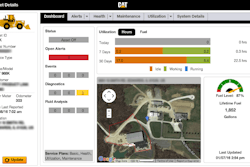Here’s an excerpt of the story “How to Find a Telematics Point Person,” from AEMP’s magazine Equipment Manager, with important advice on how to get value from equipment-monitoring technology.
Equipment owners using telematics to monitor remote equipment find that the right point person, with a balanced set of technical, equipment and fleet-management skills, is a key to rallying the company behind the technology and quickly building return on investment.
It’s not necessarily a full-time job (you might need as many as 300 units with telematics to justify a dedicated point person), but it is a challenging one.
Here are five skills essential to a contractor’s telematics point person:
1. Know the company
“Whoever it is has to understand what the organization does; that is, what its core competency is,” says Guy Gordon, CEM, director of asset management at Aegion Corp. “They must have the ability to work with and demonstrate to operations how the use of telematics can help them become more efficient. One example might be to show how the data can help identify at-risk behavior by equipment operators.”
The telematics point person must be able to look at the data and understand what is and what isn’t necessary. “Then they have to concentrate on getting the requirements implemented,” says Gordon.
Whoever fills that position has to understand from a field perspective the equipment, the different managers, the funding side of the business, and the operations people.
“What environment do these guys work in? What does the maintenance guy do? What do fuelers do?” says Christopher Seelan, president of asset-management applications developer Genesis Circle. “They need to know what data they can collect from fueling, safety, accounting and other various systems.”
In Seelan’s experience, the most successful point people have come from within the company, such as from the IT department. They’re people who are curious about how equipment is operated and how the data feeds into various parts of the back-office system. They know something of the office systems already in use and may already have relationships with stakeholders.
2. Know the telematics system
Seelan says a telematics leader “needs to have a lot of knowledge on how the application works, how to enter the data, and how to build solutions. I don’t mean they have to have hands-on experience as long as they are aware of the capabilities of the application and how to drive the data into it and get the solutions.”
3. Can talk equipment and IT
The right person will be able to engage and communicate with the organization’s IT team. They will be able to offer insight to the company’s managers when implementing telematics.
Familiarity with terminology, such as the meaning of nonproductive idle, what a speeding event is, what a braking event is, or what fault codes are, is also necessary. This is the language they need to get the system online and ensure that it is working correctly.
4. Driven to implement the technology and detail-oriented enough to see that it is done correctly
5. Must be a strong communicator
(Read the Association of Equipment Management Professionals’ complete story, “How to Find a Telematics Point Person”)




















